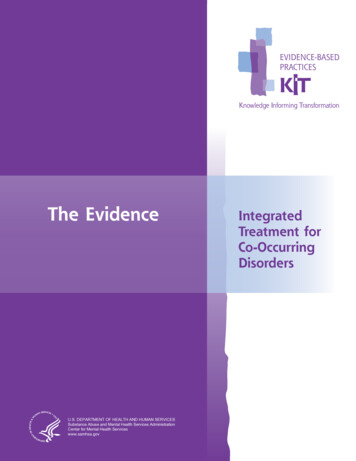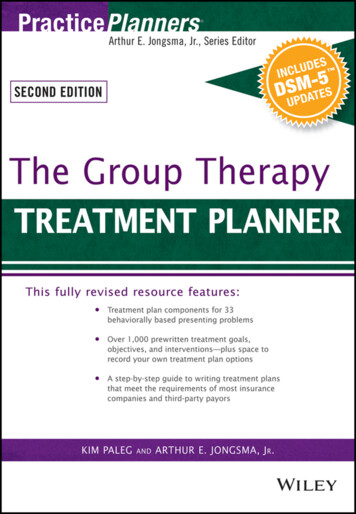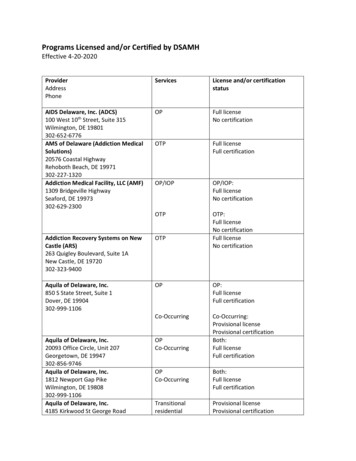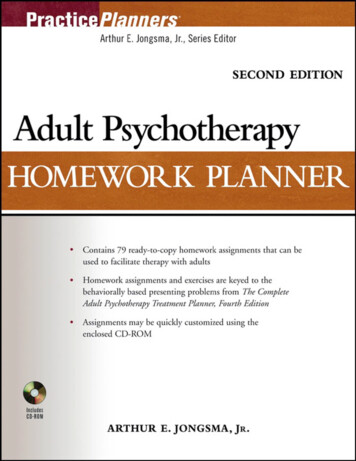
Transcription
The EvidenceU.S. DEPARTMENT OF HEALTH AND HUMAN SERVICESSubstance Abuse and Mental Health Services AdministrationCenter for Mental Health Serviceswww.samhsa.govIntegratedTreatment forCo-OccurringDisorders
TheEvidenceU.S. Department of Health and Human ServicesSubstance Abuse and Mental Health Services AdministrationCenter for Mental Health ServicesIntegratedTreatment forCo-OccurringDisorders
AcknowledgmentsThis document was produced for the Substance Abuse and Mental Health Services Administration(SAMHSA) by the New Hampshire-Dartmouth Psychiatric Research Center under contract number280-00-8049 and Westat under contract number 270-03-6005, with SAMHSA, U.S. Departmentof Health and Human Services (HHS). Neal Brown, M.P.A., and Crystal Blyler, Ph.D., served asthe Government Project Officers.DisclaimerThe views, opinions, and content of this publication are those of the authors and contributors anddo not necessarily reflect the views, opinions, or policies of the Center for Mental Health Services(CMHS), SAMHSA, or HHS.Public Domain NoticeAll material appearing in this document is in the public domain and may be reproduced orcopied without permission from SAMHSA. Citation of the source is appreciated. However,this publication may not be reproduced or distributed for a fee without the specific, writtenauthorization from the Office of Communications, SAMHSA, HHS.Electronic Access and Copies of PublicationThis publication may be downloaded or ordered at www.samhsa.gov/shin. Or, please callSAMHSA’s Health Information Network at 1-877-SAMHSA-7 (1-877-726-4727) (Englishand Español).Recommended CitationSubstance Abuse and Mental Health Services Administration. Integrated Treatment for Co-OccurringDisorders: The Evidence. DHHS Pub. No. SMA-08-4366, Rockville, MD: Center for Mental HealthServices, Substance Abuse and Mental Health Services Administration, U.S. Department of Healthand Human Services, 2009.Originating OfficeCenter for Mental Health ServicesSubstance Abuse and Mental Health Services Administration1 Choke Cherry RoadRockville, MD 20857DHHS Publication No. SMA-08-4366Printed 2009
The EvidenceThe Evidence introduces all stakeholders to the research literature andother resources on Integrated Treatment for Co-Occurring Disorders.This booklet includes the following: Two key resources included in the KIT; Additional resources for further reading; and References for the citations presented throughout the KIT.IntegratedTreatment forCo-OccurringDisorders
This KIT is part of a series of Evidence-Based Practices KITs createdby the Center for Mental Health Services, Substance Abuse andMental Health Services Administration, U.S. Department of Healthand Human Services.This booklet is part of the Integrated Treatment for Co-OccurringDisorders KIT that includes a DVD, CD-ROM, and seven booklets:How to Use the Evidence-Based Practices KITsGetting Started with Evidence-Based PracticesBuilding Your ProgramTraining Frontline StaffEvaluating Your ProgramThe EvidenceUsing Multimedia to Introduce Your EBP
What’s in The EvidenceReview of Research Literature. . . . . . . . . . . . . . . . . . . . 1Selected Bibliography . . . . . . . . . . . . . . . . . . . . . . . . . 11References . . . . . . . . . . . . . . . . . . . . . . . . . . . . . . . . . 23Acknowledgments. . . . . . . . . . . . . . . . . . . . . . . . . . . . 27IntegratedTreatment forCo-OccurringDisorders
The EvidenceReview of Research LiteratureA number of research articles summarizethe effectiveness of Integrated Treatmentfor Co-Occurring Disorders. This KITincludes a full text copy of one of them:Drake, R. E., Essock, S. M., Shaner,A., Carey, K. B., Minkoff, K., Kola,L., et al. (2001). Implementing dualdiagnosis services for clients with severemental illness. Psychiatric Services,52(4), 469-476.The Evidence1This article describes the criticalcomponents of the evidence-based modeland its effectiveness. Barriers toimplementation and strategies forovercoming them are also discussed, basedon experiences in several states.This article may be viewed or printed fromthe CD-ROM in your KIT. For a printedcopy, see page 3.Review of Research Literature
Center for Substance Abuse Treatment, SubstanceAbuse Treatment for Persons with Co-OccurringDisorders, Treatment Improvement Protocol(TIP) Series 42, DHHS Publication No. (SMA)05-3992, Rockville, MD: Substance Abuse andMental Health Services Administration, 2005.TIP 42 is accompanied by four supplements:n Quick Guide for Administrators Based on TIP42: Substance Abuse Treatment for Personswith Co-Occurring Disorders;n Quick Guide for Clinicians Based on TIP 42:Substance Abuse Treatment for Persons withCo-Occurring Disorders;Similar to this KIT, TIP 42 is a guide that providesresources for treating co-occurring mental illnessesand substance use disorders. It is an excellentcomplement to the Integrated Treatment KIT.n Substance Abuse Treatment for Persons withThe primary audiences for TIP 42 are substanceabuse treatment practitioners with varying degreesof education and experience. Secondary audiencesare policymakers and other professionals who workwith consumers who have co-occurring disorders.n Knowledge Application Program (KAP) KeysTIP 42 summarizes state-of-the-art treatmentof co-occurring disorders. It has chapters onterminology, assessment, and treatment strategiesand gives suggestions for policy planning.Co-Occurring Disorders: In-Service TrainingBased on a Treatment Improvement ProtocolTip 42; andfor Clinicians Based on TIP 42: SubstanceAbuse Treatment for Persons with CoOccurring Disorders.For a copy of TIP 42 and the supplemental guidesfor the TIP, see the CD-ROM in this KIT or go towww.ncadi.samhsa.gov.Concepts, models, and strategies outlined in TIP 42are based on definitive research, empirical support,and agreements of a consensus panel. Successfulmodels of treatment are portrayed and specificconsensus panel recommendations are citedthroughout the TIP.Review of Research Literature2The Evidence
Implementing Dual DiagnosisServices for Clients WithSevere Mental IllnessReprinted with permission from the Psychiatric Services, Copyright (2001). American Psychiatric Association.Robert E. Drake, M.D., Ph.D.Susan M. Essock, Ph.D.Andrew Shaner, M.D.Kate B. Carey, Ph.D.Kenneth Minkoff, M.D.Lenore Kola, Ph.D.David Lynde, M.S.W.Fred C. Osher, M.D.Robin E. Clark, Ph.D.Lawrence Rickards, Ph.D.After 20 years of development and research, dual diagnosis servicesfor clients with severe mental illness are emerging as an evidencebased practice. Effective dual diagnosis programs combine mentalhealth and substance abuse interventions that are tailored for thecomplex needs of clients with comorbid disorders. The authors describe the critical components of effective programs, which include acomprehensive, long-term, staged approach to recovery; assertive outreach; motivational interventions; provision of help to clients in acquiring skills and supports to manage both illnesses and to pursuefunctional goals; and cultural sensitivity and competence. Many statemental health systems are implementing dual diagnosis services, buthigh-quality services are rare. The authors provide an overview of thenumerous barriers to implementation and describe implementationstrategies to overcome the barriers. Current approaches to implementing dual diagnosis programs involve organizational and financingchanges at the policy level, clarity of program mission with structuralchanges to support dual diagnosis services, training and supervisionfor clinicians, and dissemination of accurate information to consumersand families to support understanding, demand, and advocacy. (Psychiatric Services 52:469–476, 2001)Dr. Drake and Dr. Clark are affiliated with the New Hampshire–Dartmouth Psychiatric Research Center, 2 Whipple Place, Lebanon, New Hampshire 03766 (e-mail,robert.e.drake@dartmouth.edu). Dr. Essock is with Mt. Sinai Medical School in NewYork City. Dr. Shaner is affiliated with the School of Medicine at the University of California, Los Angeles. Dr. Carey is with Syracuse University in New York. Dr. Minkoff isin private practice in Boston. Dr. Kola is with Case Western Reserve University in Cleveland, Ohio. Mr. Lynde is with West Institute in Concord, New Hampshire. Dr. Osher iswith the University of Maryland School of Medicine in Baltimore. Dr. Rickards is withthe Center for Mental Health Services in Rockville, Maryland.Substance abuse is the most common and clinically significantcomorbid disorder among adultswith severe mental illness. In this paper the term “substance abuse” refersto substance use disorders, which include abuse and dependence. “Severe mental illness” refers to longterm psychiatric disorders, such asschizophrenia, that are associatedwith disability and that fall within thetraditional purview of public mentalhealth systems. Finally, the term“dual diagnosis” denotes the co-occurrence of substance abuse and severe mental illness.There are many populations withdual diagnoses, and there are othercommon terms for this particulargroup. Furthermore, dual diagnosis isa misleading term because the individuals in this group are heterogeneous and tend to have multiple impairments rather than just two illnesses. Nevertheless, the term appearsconsistently in the literature and hasacquired some coherence as a referent to particular clients, treatments,programs, and service system issues.Since the problem of dual diagnosisbecame clinically apparent in the early 1980s (1,2), researchers have established three basic and consistent findings. First, co-occurrence is common;PSYCHIATRIC SERVICES April 2001 Vol. 52 No. 4The Evidence4693Review of Research Literature
about 50 percent of individuals withsevere mental disorders are affectedby substance abuse (3). Second, dualdiagnosis is associated with a varietyof negative outcomes, including higher rates of relapse (4), hospitalization(5), violence (6), incarceration (7),homelessness (8), and serious infections such as HIV and hepatitis (9).Third, the parallel but separate mental health and substance abuse treatment systems so common in the United States deliver fragmented and ineffective care (10). Most clients areunable to navigate the separate systems or make sense of disparate messages about treatment and recovery.Often they are excluded or extrudedfrom services in one system becauseof the comorbid disorder and told toreturn when the other problem is under control. For those reasons, clinicians, administrators, researchers,family organizations, and clientsthemselves have been calling for theintegration of mental health and substance abuse services for at least 15years (10,11).Over that time, integrated dual diagnosis services—that is, treatmentsand programs—have been steadilydeveloped, refined, and evaluated(11). This paper, part of a series onspecific evidence-based practices forpersons with severe mental illness,provides an overview of the evolutionof dual diagnosis services, the evidence on outcomes and critical components, and the limitations of current research. We also address barriers to the implementation of dual diagnosis services and current strategies for implementation in routinemental health settings.Dual diagnosis servicesTreatments, or interventions, are offered within programs that are part ofservice systems. Dual diagnosis treatments combine or integrate mentalhealth and substance abuse interventions at the level of the clinical interaction. Hence integrated treatmentmeans that the same clinicians orteams of clinicians, working in onesetting, provide appropriate mentalhealth and substance abuse interventions in a coordinated fashion. In other words, the caregivers take responsibility for combining the interventionsnesses (16). In this context, “recovery” means that the individual with adual diagnosis learns to manage bothillnesses so that he or she can pursuemeaningful life goals (17,18).Editor’s note: This article ispart of a series of papers on evidence-based practices beingpublished in Psychiatric Services this year. The papers focuson mental health practices forwhich there is substantial evidence of effectiveness and thatshould therefore be routinely offered in clinical settings. Articlesin previous issues have addressed implementing evidence-based practices for persons with severe mental illnessand in routine mental health settings and implementing sup ported employment as an evidence-based practice. Amongother topics, future articles willexamine evidence-based practices for case management andassertive community treatment,illness self-management, children’s services, and services forthe elderly population. RobertE. Drake, M.D., Ph.D., andHoward H. Goldman, M.D.,Ph.D., are the series editors.Research on dualdiagnosis practicesinto one coherent package. For the individual with a dual diagnosis, theservices appear seamless, with a consistent approach, philosophy, and setof recommendations. The need to negotiate with separate clinical teams,programs, or systems disappears.Integration involves not only combining appropriate treatments forboth disorders but also modifying traditional interventions (12–15). Forexample, social skills training emphasizes the importance of developingrelationships but also the need toavoid social situations that could leadto substance use. Substance abusecounseling goes slowly, in accordancewith the cognitive deficits, negativesymptoms, vulnerability to confrontation, and greater need for supportthat are characteristic of many individuals with severe mental illness.Family interventions address understanding and learning to cope withtwo interacting illnesses.The goal of dual diagnosis interventions is recovery from two serious ill-In most states, the publicly financedmental health system bears responsibility for providing treatments andsupport services for clients with severe mental illness. Dual diagnosistreatments for these clients havetherefore generally been added tocommunity support programs withinthe mental health system.Early studies of dual diagnosis interventions during the 1980s examined the application of traditionalsubstance abuse treatments, such as12-step groups, to clients with mentaldisorders within mental health programs. These studies had disappointing results for at least two reasons(19). The clinical programs did nottake into account the complex needsof the population, and researchershad not yet solved basic methodologic problems. For example, early programs often failed to incorporate outreach and motivational interventions,and evaluations were limited by lackof reliable and valid assessment ofsubstance abuse. Reviews based onthese early studies were understandably pessimistic (20).At the same time, however, a seriesof demonstration projects using morecomprehensive programs that incorporated assertive outreach and longterm rehabilitation began to show better outcomes. Moreover, the projectsdeveloped motivational interventionsto help clients who did not perceive oracknowledge their substance abuse ormental illness problems (21).Building on these insights, projectsin the early 1990s incorporated motivational approaches as well as outreach, comprehensiveness, and along-term perspective, often withinthe structure of multidisciplinarytreatment teams. These later studies,which were uncontrolled but incorporated more valid measures of substance abuse, generally showed positive outcomes, including substantialrates of stable remission of substanceabuse (22–25). Of course, uncon-PSYCHIATRIC SERVICES April 2001 Vol. 52 No. 4470Review of Research Literature4The Evidence
trolled studies of this type often produce findings that are not replicatedin controlled studies; they should beconsidered pilot studies, which areoften needed to refine the intervention and the methodologies of evaluation and which should be followed bycontrolled investigation to determineevidence-based practice (26).Controlled research studies ofcomprehensive dual diagnosis programs began to appear in the mid1990s. Eight recent studies with experimental or quasi-experimentaldesigns support the effectiveness ofintegrated dual diagnosis treatmentsfor clients with severe mental illnessand substance use disorders (27–34).The type and array of dual diagnosisinterventions in these programs vary,but they include several commoncomponents, which are reviewed below. The eight studies demonstrateda variety of positive outcomes in domains such as substance abuse, psychiatric symptoms, housing, hospitalization, arrests, functional status,and quality of life (19). Althougheach had methodological limitations,together they indicate that currentintegrated treatment programs aremore effective than nonintegratedprograms. By contrast, the evidencecontinues to show that dual diagnosisclients in mental health programsthat fail to integrate substance abuseinterventions have poor outcomes(35).Critical componentsSeveral components of integratedprograms can be considered evidence-based practices because theyare almost always present in programs that have demonstrated goodoutcomes in controlled studies andbecause their absence is associatedwith predictable failures (21). Forexample, dual diagnosis programsthat include assertive outreach areable to engage and retain clients at ahigh rate, while those that fail to include outreach lose many clients.Staged interventionsEffective programs incorporate, implicitly or explicitly, the concept ofstages of treatment (14,36,37). In thesimplest conceptualization, stages oftreatment include forming a trustingrelationship (engagement), helpingthe engaged client develop the moti vation to become involved in recovery-oriented interventions (persuasion), helping the motivated clientacquire skills and supports for controlling illnesses and pursuing goals(active treatment), and helping theclient in stable remission developand use strategies for maintainingrecovery (relapse prevention).Clients do not move linearlythrough stages. They sometimes enter services at advanced levels, skipover or pass rapidly through stages,or relapse to earlier stages. They maybe in different stages with respect tomental illness and substance abuse.Nevertheless, the concept of stageshas proved useful to program planners and clinicians because clients atdifferent stages respond to stagespecific interventions.Assertive outreachMany clients with a dual diagnosishave difficulty linking with servicesand participating in treatment (38).Effective programs engage clientsand members of their support systems by providing assertive out reach, usually through some combination of intensive case managementand meetings in the client’s residence (21,32). For example, homeless persons with dual diagnoses often benefit from outreach, help withhousing, and time to develop a trusting relationship before participatingin any formal treatment. These approaches enable clients to gain access to services and maintain neededrelationships with a consistent program over months and years. Without such efforts, noncompliance anddropout rates are high (39).Motivational interventionsMost dual diagnosis clients have little readiness for abstinence-orientedtreatment (40,41). Many also lackmotivation to manage psychiatric illness and to pursue employment orother functional goals. Effective programs therefore incorporate motivational interventions that are de signed to help clients become readyfor more definitive interventionsaimed at illness self-management(12,14,21). For example, clients whoPSYCHIATRIC SERVICES April 2001 Vol. 52 No. 4The Evidenceare so demoralized, symptomatic, orconfused that they mistakenly believe that alcohol and cocaine arehelping them to cope better thanmedications require education, support, and counseling to develop hopeand a realistic understanding of illnesses, drugs, treatments, and goals.Motivational interventions involvehelping the individual identify his orher own goals and to recognize,through a systematic examination ofthe individual’s ambivalence, that notmanaging one’s illnesses interfereswith attaining those goals (42). Recent research has demonstrated thatclients who are not motivated can bereliably identified (43) and effectivelyhelped with motivational interventions (Carey KB, Carey MP, MaistoSA, et al, unpublished data, 2000).CounselingOnce clients are motivated to managetheir own illnesses, they need to develop skills and supports to controlsymptoms and to pursue an abstinentlifestyle. Effective programs providesome form of counseling that promotes cognitive and behavioral skillsat this stage. The counseling takes different forms and formats, such asgroup, individual, or family therapy ora combination (15). Few studies havecompared specific approaches tocounseling, although one study didfind preliminary evidence that a cognitive-behavioral approach was superior to a 12-step approach (28). Atleast three research groups are actively working to refine cognitive-behavioral approaches to substance abusecounseling for dual diagnosis clients(12,13,44). These approaches oftenincorporate motivational sessions atthe beginning of counseling and asneeded in subsequent sessions ratherthan as separate interventions.Social support interventionsIn addition to helping clients buildskills for managing their illness andpursuing goals, effective programsfocus on strengthening the immediate social environment to help themmodify their behavior. These activities, which recognize the role of social networks in recovery from dualdisorders (45), include social network or family interventions.4715Review of Research Literature
Long-term perspectiveEffective programs recognize that recovery tends to occur over months oryears in the community. People withsevere mental illness and substanceabuse do not usually develop stabilityand functional improvements quickly,even in intensive treatment programs, unless they enter treatment atan advanced stage (19). Instead, theytend to improve over months andyears in conjunction with a consistentdual diagnosis program. Effectiveprograms therefore take a long-term,community-based perspective thatincludes rehabilitation activities toprevent relapses and to enhancegains.ComprehensivenessLearning to lead a symptom-free, abstinent lifestyle that is satisfying andsustainable often requires transforming many aspects of one’s life—for example, habits, stress management,friends, activities, and housing. Therefore, in effective programs attentionto substance abuse as well as mentalillness is integrated into all aspects ofthe existing mental health programand service system rather than isolated as a discrete substance abuse treatment intervention. Inpatient hospitalization, assessment, crisis intervention, medication management, mon ey management, laboratory screening, housing, and vocational rehabilitation incorporate special featuresthat are tailored specifically for dualdiagnosis patients. For example, hospitalization is considered a component of the system that supportsmovement toward recovery by providing diagnosis, stabilization, andlinkage with outpatient dual diagnosisinterventions during acute episodes(46). Similarly, housing and vocation al programs can be used to supportthe individual with a dual diagnosis inacquiring skills and supports neededfor recovery (47).Cultural sensitivityand competenceA fundamental finding of the demon stration programs of the late 1980swas that cultural sensitivity and competence were critical to engagingclients in dual diagnosis services (21).These demonstrations showed thatAfrican Americans, Hispanics, andother underserved groups, such asfarm workers, homeless persons,women with children, inner-city residents, and persons in rural areas,could be engaged in dual diagnosisservices if the services were tailoredto their particular racial, cultural, andother group characteristics.Many dual diagnosis programs omitsome of these critical components asevidence-based practices. However,one consistent finding in the researchis that programs that show high fidelity to the model described here—those that incorporate more of thecore elements—produce better outcomes than low-fidelity programs(32,48,49). A common misconceptionabout technology transfer is thatmodel programs are not generalizableand that local solutions are superior.A more accurate reading of the re search is that modifications for cultural and other local circumstancesare important, but critical programcomponents must be replicated toachieve good outcomes.Limitations of the researchThe design and quality of researchprocedures and data across dual diag nosis studies are inconsistent. In addition, researchers have thus farfailed to address a number of issues.Dual diagnosis research has studiedthe clinical enterprise, that is, treatments and programs, with little attention to the policy or system perspective. Despite widespread endorse ment of integrated dual diagnosisservices (13,50–53), there continuesto be a general failure at the federaland state levels to resolve problemsrelated to organization and financing(see below). Thus, despite the emergence of many excellent programsaround the country, few if any largemental health systems have been ableto accomplish widespread implementation of dual diagnosis services forpersons with severe mental illness.We are aware of no specific studies ofstrategies to finance, contract for, re organize, or train in relation to dualdiagnosis services.Lack of data on the cost of integrated dual diagnosis services and thecost savings of providing good careimpedes policy development. Dualdiagnosis clients incur high treatmentcosts in usual services (54,55), andcare is costly to their families (56), buteffective treatment may be evenmore costly. Some studies suggestcost savings related to providing goodservices (57,58), but these are not definitive.Another limitation of the researchis the lack of specificity of dual diagnosis treatments. Interventions differacross studies, manuals and fidelitymeasures are rare, and no consensusexists on specific approaches to individual counseling, group treatment,family intervention, housing, medications, and other components. Currentresearch will address some of these issues by refining specific components,although efficacy studies may identifycomplex and expensive interventionsthat will be impractical in routinemental health settings.A majority of dual diagnosis clientsrespond well to integrated outpatientservices, but clients who do not respond continue to be at high risk ofhospitalization, incarceration, homelessness, HIV infection, and other serious adverse outcomes. Other thanone study of long-term residentialtreatment (33), controlled researchhas not addressed clients who do notrespond to outpatient services. Otherpotential interventions include outpatient commitment (59), treatmentsaimed at trauma sequelae (60), money management (61), contingencymanagement (62), and pharmacological approaches using medicationssuch as clozapine (63), disulfiram(64), or naltrexone.Although a few studies have explored the specific treatment needsof dual diagnosis clients who arewomen (65,66) or minorities (21,67),particular program modifications forthese groups need further validation.For example, many dual diagnosisprograms have identified high rates oftrauma histories and sequelae amongwomen (46,68,69), and studies havesuggested interventions to addresstrauma; however, no data on outcomes are yet available.Implementation barriersAlthough integrated dual diagnosisservices and other evidence-basedpractices are widely advocated, theyPSYCHIATRIC SERVICES April 2001 Vol. 52 No. 4472Review of Research Literature6The Evidence
are rarely offered in routine mentalhealth treatment settings (70). Thebarriers are legion.ing dual diagnosis interventions andlack the resources to train currentsupervisors and clinicians.Policy barriersState, county, and city mental healthauthorities often encounter policiesrelated to organizational structure,financing, regulations, and licensingthat militate against the functionalintegration of mental health and substance abuse services (71). The U.S.public mental health and substanceabuse treatment systems grew inde pendently. In most states these services are provided under the auspicesof separate cabinet-level depart ments with separate fundingstreams, advocacy groups, lobbyists,enabling legislation, information systems, job classifications, and criteriafor credentials. Huge fiscal incen tives and strong political allies act tomaintain the status quo.Medicaid programs, which fund asignificant and growing proportionof treatment for persons with severemental illness, vary substantiallyfrom state to state in the types ofmental health and substance abuseservices they fund. In most states,mental health and substance abuseagencies have little control over howMedicaid services are reimbursed oradministered, which makes it diffi cult for public systems to ensure thatappropriate services are accessible.Medicare, the federal insurance program for elderly and disabled persons, generally pays for a more limit ed scope of mental health and sub stance abuse services. TogetherMedicaid and Medicare pay formore than 30 percent of all behavioral health services, but their impact on dual diagnosis services hasnot been studied (72).Clinical barriersThe beliefs of the mental health andsubstance abuse treatment traditionsare inculcated in clinicians, which diminishes the opportunities for crossfertilization (73). Although an integrated clinical philosophy and a practical approach to dual diagnosis treatment have been clearly delineated formore than a decade (16), educationalinstitutions rarely teach this ap proach. Consequently, mental healthclinicians typically lack training indual diagnosis treatment and have torely on informal, self-initiated opportunities for learning current interventions (74). They often avoid diag
The Evidence. Review of Research Literature. A number of research articles summarize the effectiveness of Integrated Treatment for Co-Occurring Disorders.










